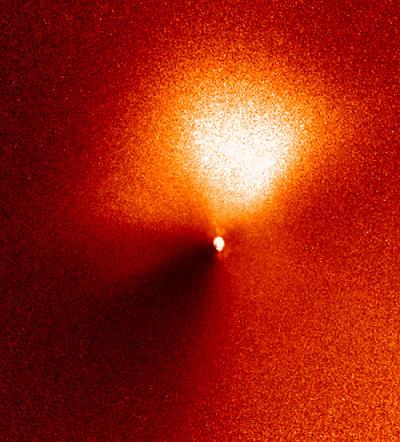Two weeks ago, astronomers thought that bursts of material from comets were rare. But now, thanks to Deep Impact, technical partners, and a kind host comet, scientists can get a closer look at this kind of activity and predict what will happen when the probe from the Deep Impact spacecraft crashes into comet Tempel 1 on 4/7/05

By: Michal Levinstein, Israeli Astronomical Society
Two dust jets erupting from comet Tempel 1 as imaged by the Hubble Space Telescope. Credit: NASA, ESA.
Two weeks ago, astronomers thought that bursts of material from comets were rare. But now, thanks to Deep Impact, technical partners and a kind host comet, scientists can get a closer look at this kind of activity and predict what will happen when the probe from the Deep Impact spacecraft crashes into comet Tempel 1 on 4/7/05.
On 14/6/04 and 22/6/05, the scientists observed 2 new dust jets erupting from the comet Tempel 1. Because the comet was the center of attention of the Hubble Space Telescope, the Spitzer Telescope, the Chandra Observatory and countless other telescopes - The eruptions could not have happened at a more appropriate time.
"Eruptions may be a common phenomenon in many comets," says astronomer Michael A'Hearn from the University of Maryland and head of the Deep Impact project team. "We could have easily missed these exciting events if we weren't currently photographing the comet with the equipment of the Deep Impact spacecraft - cameras and spectroscopic equipment."
On 14/6/05, the Hubble Telescope's sophisticated camera, designed for high-resolution surveys, captured precise details of a 1,320-mile-long jet spreading from the comet's nucleus toward the Sun. The cameras on the Deep Impact also recorded the eruption.
On 22/6/05, the comet provided scientists with another burst. This time the jet was 6 times bigger than the jet 8 days before. The spectrometer on board the Deep Impact this time measured water vapor and gas quantities emitted from the comet several times greater than those of the previous eruption. The emitted material dissipated in about half a day.
The pair of outbursts that happened in just two weeks lead astronomers to consider this kind of activity to be common in comets as they approach the Sun.
Project scientists hope that the outbursts are just a prelude to what's to come when the collision with comet Tempel 1 occurs. The collision will release dust, ice, gas and debris from the comet. While doing so, the Deep Impact will record the event with 3 devices: a medium resolution digital camera, a high resolution digital camera and a spectrometer.
Ahern says the most significant aspect of the second burst was that at the same time the Deep Impact spacecraft was both photographing the comet and measuring its spectrum at the same time.
"We saw big changes in the spectrum - both in the spectral sequence and in the emission bands of the molecules. This was the first real test of our spectroscope in an interesting scientific problem" says Aharen. "The eruptions taught us that the results of the collision will be spectacular."
Thanks to the 2 eruptions, the project engineers are convinced that the Deep Impact instruments are indeed ready for the big event of 4/7/05. According to Jessica Sunshine from the project, "we can already see changes in the make-up of the fresh material that came out of the comet".
What - if anything - will telescopes on Earth and in space be able to see during the collision? "It already depends on the physical structure of the comet" says Aharan. "There are models - not the most accepted, but reasonable - that predict that very little will be seen by the means on Earth and in space."
"All the mission scientists feel confident, but not absolutely, that they will get a collision in the location they wanted," says Lee Tune - a science reporter on the mission team.
The best bet, according to the scientists, is for a large crater to form with a lot of material ejected from it. But there are also other options. For example - the probe that will collide with the comet may drill a hole in the form of a tunnel through the comet Tempel 1. In any case, the scientists do not expect the comet's ice core to disintegrate as a result of the collision.
The mission team members are already thinking about more future Deep Impact encounters with another comet – this time, of course, without the fireworks.
"We would like to reach another comet - Boethin - but we have not received approval or funding for this," says team member Lucy McFadden. "We await the collision to decide the future of the Deep Impact spacecraft."
